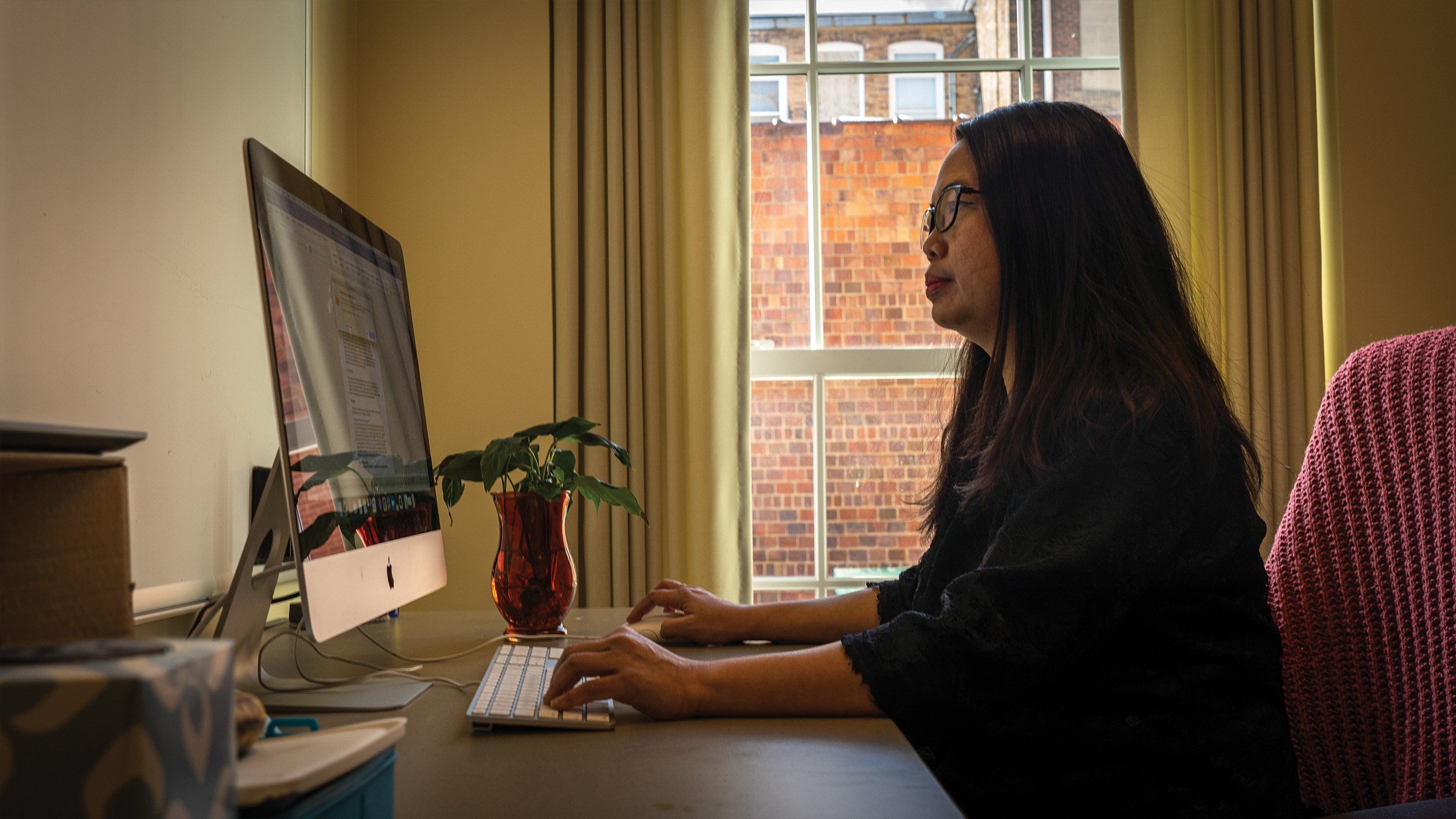The Country of Islands and Kindness
Story by McKenna Christy
Photos by Aziz Al Fadha
An OU teacher and a doctoral student from Indonesia feel their culture is united by the generosity of their neighbors.
Hasanah and Ariyanti pose for a photo on the College Green on Jan. 25, 2022.
During the first week of fall semester, Uswatun Hasanah was standing outside of Baker Center talking about her home country of Indonesia. Hasanah asked what I knew about Indonesia, which was little to nothing, but she took the time to teach me about the tens of thousands of islands making up the country and the hundreds of millions of people living there.
Hasanah currently teaches Elementary Indonesian I at Ohio University and is a Fulbright Foreign Language Teaching Assistant — an exchange program for abroad studies, teaching and more. Hasanah came to teach at the beginning of the school year and traveled far from home to do so.
“I live in Banten province so it’s only two hours driving from Jakarta, the capital. It’s in Java Island because as we know that Indonesia is the country of islands,” Hasanah says.
Although the Embassy of the Republic of Indonesia states there are 17,508 islands, with 6,000 being inhabited by the population, there are five that are considered to be the “main” islands.
“We have five big islands: Sumatra Island, and then Java Island — where the capital is located [and] includes my province of course,” Hasanah says. “Then Sulawesi Island, Kalimantan Island [and] Papua Island. And then one of them, Sumatra Island, it’s one of the biggest islands in the world, it’s maybe in the sixth [largest] range.”
In Hasanah’s class she balances teaching Indonesian language, which she says can be called Bahasan Indonesia, along with the cultural aspects of the country such as how Indonesian students address their teachers. When Hasanah took a few classes at the University of Virginia Tech in 2011, her professor asked to be called by their first name and Hasanah recalls being shocked by the request.
“… I was like, ‘no way it would ever happen in my country.’ We talk about that, and they feel really excited to learn about something new. Even in my class, I asked them to call me ‘Ibu Uswatun,’ Ibu means mother,” Hasanah says. “But that’s the way we call our teachers or maybe older women.”
Hasanah had two students in her class for the fall semester. She explains that Indonesian is considered a less commonly taught language compared to Spanish or German.
Hasanah, making peace symbol with her hands on college green.
“I’m really thankful that those two students enrolled into my class and my very first question is like, ‘what is your reason?’ I mean I’m very grateful and those two students are very nice and then we are comfortable in this very small class,” Hasanah says. “It’s more like [a] private class and we can be very open and be the way we are.”
The two students learning Indonesian in Hasanah’s class do not represent the popularity of the language in Indonesia and the amount of people living there. Statista states that as of 2021, the population of Indonesia is 272.25 million people and as of 2010, 87 percent of those people are Muslim.
“So, we are not applying Islamic law but since most people are Muslim of course [Islam] influences the culture itself,” she says.
But, according to Hasanah, the culture in Indonesia remains open and welcoming to other groups of people and religions because respect and kindness are some of the most important cultural defining parts of Indonesia.
“Politeness is maybe number one. And we always think before acting because we don’t want to offend people, it shows up from the way we interact,” she says. “For example, it’s not common here for, and as I learned that, asking somebody’s age is kind of rude here. But in my country, it’s very common, it’s not because we want to know all about you, it’s because we want to know if you are younger or older because we have differences for every people.”
Ratna Ariyanti, a doctoral student of journalism at OU, similarly observes that in Jakarta, the city she was born in, caring for one another is a significant aspect of Indonesian culture.
Ariyanti has spent most of her life in Indonesia. After receiving her Bachelor of Arts in mass communication from Sebelas Maret University in Indonesia, Ariyanti began working as a journalist for Business Indonesia and joined the Alliance of Independent Journalists where she advocates to improve media worker’s conditions. She then moved on to the academia sector of work and currently teaches at the Multimedia Nusantara University.
“I started to teach I think probably around 2010. So, during my spare time, like in the week … I usually teach two times in a week in one of the faculty facilities,” Ariyanti says. As an advocate for change in media worker’s conditions, she says one must pursue a higher education to see a change.
Ariyarti looking at her computer Jan. 25, 2022.
In 2019, Ariyanti applied for funding to earn her Ph.D. and received a grant from the Fulbright Program. She wanted to attend OU because there is a strong presence of alumni who are from Indonesia. Ariyanti also related to the faculty members and their commitment to academia. Pursuing her Ph.D. in Ohio meant leaving her mom, who lived with Ariyanti, but she knew her mom would be taken care of.
“My mother lived with me from when I stopped being a full-time journalist,” she says. “When I was about to move, I [knew] she’ll be fine because the neighbor is regularly checking on her. People are just very nice, it’s very easy to reach your neighbors to ask for help.”
Her neighborhood’s dedication to caring for one another is one of the cultural aspects Ariyanti misses about Indonesia. Something else she misses is going to the grocery store.
“When people bought groceries, they exchanged conversation, so that’s the thing that I miss the most. Sometimes it can be annoying like people want to know anything like, ‘I didn’t see you for days are you going somewhere?’ But when you are away from home, that’s the thing they miss the most,” she says.
In Indonesia it is common for people to always bring food to each other’s houses, but Ariyanti has acknowledged the food restrictions people have here. For this reason, she now brings house plants to people. Although Ariyanti adapted to this cultural difference, she continues to bring the kindness that was instilled in her by living in Indonesia.
“I was raised to always care about each other,” Ariyanti says. “Even when I’m here, my mother is still telling me, for instance, the neighbor next door [had] an accident a couple weeks ago. From here, I still have access to order from our marketplace. So for me the feel[ing] to always talk [to] others and helping, that [is] because my mother has already lived with this kind of attitude since I was a child.”
Despite many cultural differences, there are certain similarities to note between American and Indonesian culture.
“I find it quite different here, which I like,” Hasanah says. “In some ways sometimes, we judge people from the appearance. We have some similarities, I think, at least according to me. Indonesian people and American people are very friendly, that’s what similar. We say hello to strangers. And there are a lot of things here like people can just compliment you even if we’re strangers [we can say] ‘hey I like your shirt, I like your hijab,’ even sometimes. It’s so warm.”




